Submitted by Tyler Durden of Zero Hedge
For readers who have the time and interest to follow up on the topic Zero Hedge commenced yesterday discussing money liquidity and the shadow banking system, the best place to start is with Friedrich Hayek’s seminal Prices and Production, published in the depression days of 1935. Curiously Hayek discerned the critical role of the shadow banking system long before the advent of securitization, derivatives and other products that today have caused the monetary supply problem to reach a screaming crescendo. A very salient sample is presented below:
“There can be no doubt that besides the regular types of the circulating medium, such as coin, notes and bank deposits, which are generally recognised to be money or currency, and the quantity of which is regulated by some central authority or can at least be imagined to be so regulated, there exist still other forms of media of exchange which occasionally or permanently do the service of money. Now while for certain practical purposes we are accustomed to distinguish these forms of media of exchange from money proper as being mere substitutes for money, it is clear that, other things equal, any increase or decrease of these money substitutes will have exactly the same effects as an increase or decrease of the quantity of money proper, and should therefore, for the purposes of theoretical analysis, be counted as money.
In particular, it is necessary to take account of certain forms of credit not connected with banks which help, as is commonly said, to economize money, or to do the work for which, if they did not exist, money in the narrower sense of the word would be required. The criterion by which we may distinguish these circulating credits from other forms of credit which do not act as substitutes for money is that they give to somebody the means of purchasing goods without at the same time diminishing the money-spending power of somebody else. This is most obviously the case when the creditor receives a bill of exchange which he may pass on in payment for other goods. It applies also to a number of other forms of commercial credit, as, for example, when book credit is simultaneously introduced in a number of successive stages of production in the place of cash payments, and so on. The characteristic peculiarity of these forms of credit is that they spring up without being subject to any central control, but once they have come into existence their convertibility into other forms of money must be possible if a collapse of credit is to be avoided.”
Great 500+ page read for a Sunday afternoon. As for some more generic, brief (and modern) thoughts, I provide a few personal observations.
First, a run through the orthodox framework.
A basic account of money supply starts with the monetary aggregates that matter most for CPI inflation: in the case of the US this includes cash balances in aggregates such as the M2 (total deposits) or MZM (zero maturity money/cash plus bank claims and money market funds). The traditional recent definition of “available stock” of money consists of the cash notional of money printed by the central bank (outside money) and how much the banking system has created by making loans (inside money). Of course, due to the deposit multiplier effect, the inside money is much bigger than outside money. For the purposes of this narrative, the impact of securitization and derivatives (tier 3 and 4) will not be discussed currently as the complexity involved would take a big turn for the uglier. It will, however, be a topic pursued in the future.
The chart below shows the relative composition of inside money (mostly deposits) was almost ten times the outside money (monetary base) prior to the recent crisis.
Furthermore, as the historical chart demonstrates below, while rare, it has occurred, most notably during the Great Depression, that the broader money stock and monetary base moved in opposite directions.
A looking at the other side of the equation: demand, is the desired cash balances held by the public. Money demand rises via transactions demand with a growing economy, and falls when interest rates rise as zero-yielding cash becomes less attractive. Some math: money demand is the inverse of the velocity of money. If MV=PY (where M is money stock, V is velocity and PY is nominal GDP), then (1/V) = (M/PY), which is the level of money stock relative to nominal GDP. For households, 1/V can be represented as the desired money holdings as a share of nominal income. If a household decided to increase their money holding to 9 months of income from 6 months (a process occuring pervasively in the current environmen tof job and otherwise insecurity and lack of trust), V would fall to 1.33 from 2x.
This is, in simple terms, the standard approach. As the bolded section of Hayek’s quote demonstrates, however, it does not go far enough. What he is trying to convey, is that the economy, like any other constantly shifting “ecosystem” can create its own media of exchange in order to “economize” on the use of inside and outside money for use in the purchasing of assets. Once assets themselves can serve as collateral, allowing for leverage purchases, they also take on money-like properties. And, herein lies the rub, when financial assets serve as collateral for borrowing to purchase yet more assets (margin purchasing), this kind of shadow money becomes especially potent in driving asset price overshoots and bubbles. The chart below demonstrates the various parts of the credit cycle from the perspective of shadow money.
A good form summary of a credit bubble is presented below, compliments of Credit Suisse:
It starts with some genuine investment opportunity almost always related to a real improvement in technology or fundamentals. As strong price performance turns into a boom, optimistic investors desire to buy more on margin. They leverage up, usually using the buoyant asset itself as collateral. Lenders are all too willing to benefit by funding these purchases – after all, in the worst case, they will be holding valuable collateral. Borrowing terms such as haircuts, loan-to-value ratios, or margin requirements get easier. New money flows in, and associated financial assets begin to take on money-like attributes.
As buying on leverage accelerates, prices and credit conditions blow past what is warranted by fundamentals. There is a monetary expansion in the broad sense of shadow money, but when the bust comes this is quickly reversed. Lending conditions tighten, collateral prices plummet, and highly leveraged optimists are wiped out. Now cash is king; investors do not want houses, stocks, tulips or asset-backed commercial paper. To accommodate this demand for cash the government/central bank must quickly and forcefully expand the monetary base or else the increase in money demand can lead to a painful general deflation.
Meanwhile, the sudden disappearance of good collateral in the financial system has created a dangerous de-leveraging that could feed on itself. The government may respond by increasing its own debt, since public collateral in the forms of treasury bills and such do still have funding liquidity, and by flooding the market with government paper the leverage collapse can be better managed. In this example effective money (meaning shadow money plus the conventional money stock) falls sharply, but it would have fallen much more without aggressive policy actions.
As shadow money is a pro-cyclical, boom-time phenomenon, serving as a medium of exchange to finance a bubble, it affects asset prices directly, but only indirectly affects goods and services prices. An approach to estimate shadow money is calculating the immediate cash embodied in various debt securities: this can be done using asset haircuts in repo markets as well as current market values at FMVs in four points in time: early ’07, 2008 Pre Lehman, 2008 Post Lehman, and currently.
If the market had outstanding securities worth $100 billion and repo haircuts of 5%, then effective money would be $95 billion. If prices fell 50% and repo haircuts rose to 20%, effective money would be ($100* 0.5)*(1-20%) = $40 billion. Some asset haircuts are presented below in the attempt to determine effective money.
The exhibit below estimates the size of effective US money stock as a sum of inside and outside money as well as shadow money, broken by private and public.
A simplified breakdown of public and private effective money stock is presented on the next chart.
Lastly, in order to demonstrate the dramatic outflow in private shadow money in the immediately pre/post Lehman economy, and just how effectively subdued the public shadow money response has been in dealing with the pull back of the private sector. Credit Suisse estimates that since 2007 the shadow money in private debt securities (IG, HY bonds, non-agency RMBS, CMBS and ABS) has fallen by 38% or $3.6 trillion to $5.9 trillion, mostly due to a drop in market values, a scarcity of new issuance and, most importantly, a huge increase in repo haircuts. To compensate for this, public shadow money represented by treasuries, agency bonds and agency RMBS, has risen by $2.8 trillion, driven by an unprecedented ramp up in treasury and MBS issuance, and an increase in relevant asset prices.
It is immediately obvious that the expansion of public shadow money is no match for the massive contraction seen in the private side. In this light, the question of the efficacy of the QE rollout and other public shadow money expansion has a tinge of futility to it, and not just in terms of money supply inflection points. The continued risk aversion by banks means inside money contraction, and not outside money expansion, is the threat. Not just the wilful allowance of rising inflation by policy makers, but, much more relevantly, a recovery in loan creation is needed. As Keynes noted, in assessing money demand, in addition to interest rates and growth, the subject of “liquidity preference” is critical – the desire by the public to hold (often abnormally large) cash balances as buffers in times when bad economic outcomes are feared, such as currently. As liquidity preference is a mass psychology phenomenon, it is impossible to quantify and predict. A huge increase in cash demand at a time of weak growth is a rare, dangerous and deflationary occurrence, and tends to occur exactly at financial crises such as this one. The administration’s, and the media’s, massaging of mass psychology through the constant and repeated message that all is well, in order to rekindle the liquidity preference by the general public, makes all the sense in the world, as absent its intangible “benefit” the road to recovery is doomed from the onset.
But is even this propaganda machine doomed, in a more subversive way? As households whose HELOCs have been cut or whose home equity has diminished, firms whose commercial property has collapsed in value, and banks whole ability to borrow in collateral markets to raise cash has fallen, all face the same problem: as the ability to raise cash has fallen, actual cash holdings must rise. And, unfortunately for the Obama administration, this is not a temporary hoarding, this is a permanent rebalancing in the trillions of dollars order of magnitude. As money demands skyrockets, the velocity of money plummets.
In the pro-cyclical boom of 2002-2007 many components of everyday lives became a derivative of the shadow money system: repo lending became critical to credit creation; home equity extraction became a key means to smooth consumer spending during period of low or no income; off-balance sheet funding of various assets became a major earnings generator for commercial banks. Yet the process appears not to have affected money demand and supply: regular bank loan growth was limited, keeping money stock from soaring, and money demand was held back by beliefs in easy availability of borrowing against collateral. Most dangerously, economic policy, first through Greenspan then Bernanke, was complicit in allowing the boom by emphasizing price level inflation and not effective money. With regular M2 and MZM money supply and demand effected only indirectly by the credit boom and a massive output gap following the 2001 recession, it was never an issue that inflation would soar. A similar credit boom occurred with no inflation in the 1920s also, another period where a major collateralized credit pyramid was built virtually on top of a reasonably stable money stock. The reason, then, as now, key decision-makers did not notice a massive credit pyramid was being built, is because traditional money indicators, which this post argues are essentially useless in the context of today’s much more sophisticated from a money and liquidity perspective economy, were fairly stable. If there is one “crime” for which the most two recent chairmen of the Fed should be held in ridicule in hsitory books, it is precisely this. And yet while Greenspan may be somewhat forgiven due to his less academic nature, Bernanke, who was a depression “specialist”, should have seen our current predicament coming from miles. That he failed to do so is why future historians and market pundits will not spare him the criticism of being among the primary culprits for the current, multi-generational crisis. In the meantime, the propaganda issuing from every media source is to be expected (and in some ways welcomed) – it merely demonstrates that the administration finally grasps the severity of the problem, and the need for confidence to rematerialize, even if it is through the current meme of Green Shoots (whose very existence is flawed flawed upon more than a cursory examination, whether it is due to seasonal factors, subsequent economic data adjustments, or outright misrepresentations).
Yet now that any hope of a preventative approach has failed and we are stuck with the consequnces, what happens? In order for there to even be hope of recovery, money stock has to rebound. Not only Bernanke, or Geithner, but Obama himself has now demontrated that he is on the same page with regard to explanding the shadow money stock (while presumably providing better oversight and supervision).
For now, the immediate focus should be on whether confidence can return: in collateral, in lending, in risk taking, in entrepreneurship. In the meantime, any talk of inflation is premature. The deflationary shock has to wear off first, and in many asset classes it has not even accelerated yet.
It is ironic that shadow money and credit are not just the dynamo that drives the free market, but also its Achilles heel. While most of the time they serve a useful purpose, currently their purpose is a destructive one as long as they continue to trendline away from recent asymptotes. If history is any indication, the overshoot to the downside will likely be just as severe as the upside overshoot was protracted. In that case, nothing the Fed does can accelerate inflation. Also, while possible that Bernanke has something up his sleeve, it is improbable.
Thus while the market continues trading on a sepculative basis and conjecture rooted in the casino psychology that has gripped equity markets (and recently credit markets as well), the long term picture is much less sanguine as the excesses of the credit cycle from the past 60 years wear off and not only asset prices but also repo haircuts find a new equilibrium.
What is certain is that the near-term economy will be driven in spurts and starts as mass psychology shifts from one extreme to another. The next catalyst in my view will be the interplay of the impact of stimulus spending coupled with the failure of the green shoots materializing into anything worthwhile. And while this will make the life of daytraders interesting, the traditional buy and hold approach to asset accumulation must be delayed indefinitely, until the critical equilibrium discussed above is achieved. Until that happens, anyone who claims the economy is headed in the right direction (either much higher or much lower), is merely spreading their own agenda or has an opinion that is fundamentally not rooted in actual facts.
Thanks to Credit Suisse for primary observations and ideas and hat tip to Gunther.
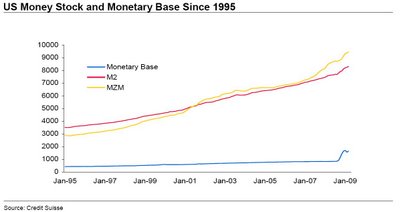
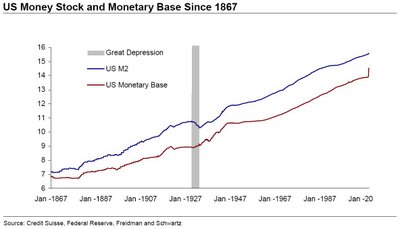
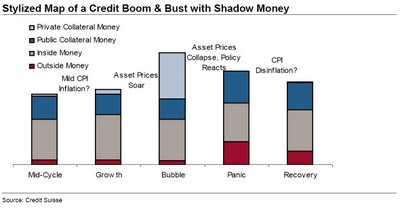
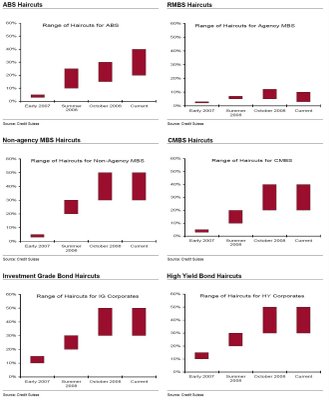
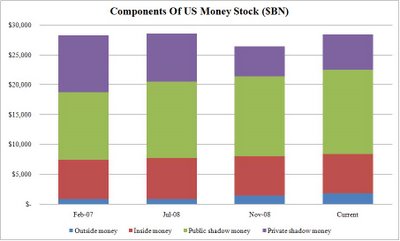
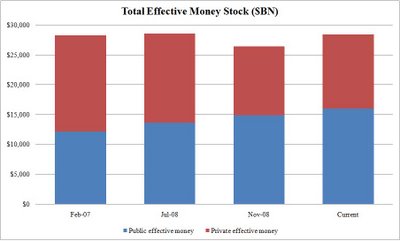
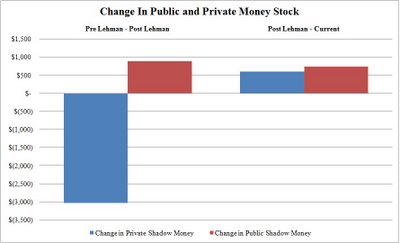


Without any doubt the very best blog on economics and finance is:
http://zerohedge.com
good of Yves to feature ZH – class act all the way
The decade around 1935 is an interesting time for finance, i.e, with Friedrich Hayek and a few shadow figures in Germany (around The “Global” Great Depression). It’s interesting that these unregulated forms of fraud are at the apex of our neo-capitalist society. Obviously, The Fascist agenda is no longer in the shadows.
Mefo bills Hjalmar Schacht formed the limited liability company Metallurgische Forschungsgesellschaft, m.b.H., or “MEFO” for short. The company’s “mefo bills” served as bills of exchange, convertible into Reichsmark upon demand. MEFO had no actual existence or operations and was solely a balance sheet entity. The bills were mainly issued as payment to armaments manufacturers.
Mefo bills were issued to last for six months initially, but with the provision for indefinite three-month extensions. The total amount of mefo bills issued was kept secret.
Essentially, mefo bills enabled the German Reich to run a greater deficit than it would normally have done. By 1939, there were 12 billion Reichsmark of mefo bills, compared to 19 billion of normal government bonds.
This enabled the government to reinflate their economy, which culminated in its eventual rearmament.
The decade around 1935 is an interesting time for finance, i.e, with Friedrich Hayek and a few shadow figures in Germany (around The “Global” Great Depression). It’s interesting that these unregulated forms of fraud are at the apex of our neo-capitalist society. Obviously, The Fascist agenda is no longer in the shadows.I’m confused … are you trying to draw a link between Hayek and German fascism?
“as the ability to raise cash has fallen, actual cash holdings must rise. And, unfortunately for the Obama administration, this is not a temporary hoarding, this is a permanent rebalancing in the trillions of dollars order of magnitude. As money demands skyrockets, the velocity of money plummets.”
This sounds to me like your saying that a Flight to Safety does just that. Money ends up in safe investments. However, this is real money. So some people have money.
“For now, the immediate focus should be on whether confidence can return: in collateral, in lending, in risk taking, in entrepreneurship. In the meantime, any talk of inflation is premature. The deflationary shock has to wear off first, and in many asset classes it has not even accelerated yet.”
Shouldn’t we attempt to attack the Fear and Aversion to Risk and the Flight to Safety with disincentives to save and incentives to invest? I’m not sure how we would know that they work until we try them.
As for QE, if short term interests rates are low, and longer term rates begin to go up, then you have a disincentive to save and a longer term signal of confidence. That seems good to me. It won’t work on its own, but with rising stocks, a short term sales tax decrease, tax incentives for investment, and some govt spending, you can at least have a plan to attack the problem. It doesn’t strike me as a priori false or doomed to fail.
As for the casino, I never get that analogy, since there’s a winner: namely, the casino. The money doesn’t disappear.
Don the libertarian Democrat
Re: “are you trying to draw a link between Hayek and German fascism?
No, I’m just pointing out that around The Great Depression, there were lots of clever people playing with financial theories and applications; MEFO Bills are an example of shadow banking. This derivative and fraud stuff isn’t new and it always involves engineering which bypasses regulations and oversight.
It is also interesting and somewhat related, that most of the financial engineering that does take place, is done right under everyones nose. As a bad example from the same general era, propaganda from Woody Wilson influenced and persuaded Americans to support World War l by using their own cash to invest in Liberty BondsAll I’m suggesting there is, that large scale financial movements that connect general passions of patriotism or greed happen all the time; we just saw it with Iraq, and the entire wall street/Bush Ownership Society Thing and also with icons like Madoff, who spin hype into attractive packages that people will buy — kinda like TARP. If the PR is really good and BIG enough, you can drop the concept of fraud altogether and then bring in a few economists and create jobs ….LOL!
I’m feeling Bob Dylan:
Bob Dylan – JokermanAlso consider: In January 1931, before his lectures series at LSE, Hayek gave a one-lecture version to the Marshall Society at Cambridge. Keynes was unable to attend the lecture, but Richard Kahn was in the audience. After Hayek’s lecture there was complete silence induced by disbelief. Kahn broke the ice by asking: “Is it your view that if I went out tomorrow and bought a new overcoat, that would increase unemployment?” “Yes,” Hayek was supposed to have replied, turning to the blackboard filled with triangles, “but it would take a very long mathematical argument to explain why.”
After reading Mandelbrot and Taleb, anytime I see the word “equilibrium” used, it immediately throws red flags up all over the place.
For instance:
If you hear a “prominent” economist using the word equilibrium (emphasis Taleb’s), or normal distribution, do not argue with him; just ignore him, or try to put a rat down his shirt.~
or
Things got a lot worse in 1997. The Swedish academy gave another round of Gaussian-based Nobel Prizes to Myron Scholes and Robert C. Merton, who had improved on an old mathematical formula and made it compatible with the existing grand Gaussian general financial equilibrium (emphasis mine) theories–hence acceptable to the economics establishment.~
–Nassim Nicholas Taleb, The Black Swan
Fantastic piece. Right in there with http://www.debtdeflation.com/blogs/2009/01/31/therovingcavaliersofcredit/ and http://globaleconomicanalysis.blogspot.com/2009/02/fiat-world-mathematical-model.html
The characteristic peculiarity of these forms of credit is that they spring up without being subject to any central control, but once they have come into existence their convertibility into other forms of money must be possible if a collapse of credit is to be avoided.”——-
W. Leatham (banker of Yorkshire) writes in his Letters on the Currency, 2nd ed., London, 1840:
“I find, then, the amount for the whole of the year of 1839 … to be £528,493,842” (he assumed that the foreign bills of exchange made up about one-fifth of the total) “and the amount of bills out at one time in the above year, to be £132,123,460” (p. 56). The bills of exchange make up “one component part greater in amount than all the rest put together” (p. 3). “This enormous superstructure of bills of exchange rests (!) upon the base formed by the amount of bank-notes and gold, and when, by events, this base becomes too much narrowed, its solidity and very existence is endangered” (p. 8). “If I estimate the whole currency”
(he means of the bank-notes)
“and the amount of the liabilities of the Bank and country bankers, payable on demand, I find a sum of 153 million, which, by law, can be converted into gold … and the amount of gold to meet this demand” only 14 million (p.11). “The bills of exchange are not … placed under any control, except by preventing the abundance of money, excessive and low rates of interest or discount, which create a part of them, and encourage their great and dangerous expansion. It is impossible to decide what part arises out of real bonâ fide transactions…[quoted in Marx, Capital Vol III, Ch 25, Credit and fictitious capital]
1. DownSouth is, as usual, obviously correct about any casual use of the idea of “equilibrium.”
2. Further, Hayek is, as usual, a very prescient source. I recall with humor how I first encountered Hayek, as the supposed source of Reagan’s and Thatcher’s ideology. What lunacy was borne of Hayek’s sound words. I doubt there is anyone other than Smith whose words were more hijacked irrationally than Hayek’s. And it’s still occurring, with both Smith and Hayek. Thankfully, a few, as seen in this post, still respect the actual thought underlying Hayek’s philosophy. If only we could get the lunatics to actually *read* Hayek…oh well, I guess I wish for too much. Is it really too much for ask the economists and bloggers and commenters to just read Hayek’s words, to actually consider his philosophy, before a knee jerk request for lower taxes and anarchy? I suppose not. Oh well.
A request for lower taxes and anarchy could be put differently, without smearing advocates of liberty and invisible hand market allocation of funding. AIG should have collapsed, the scoundrels and their enablers put in prison years ago.
Courtesy of Zero Hedge, a link to Times Online:The man with the trillion dollar bounty”
The culprit is of course Fractional Reserve Banking .
Fractional Reserve Banking is by its very nature unstable in changing economic circumstances, leveraging one way or another depending on the growth or contraction in the economy …
What it has spawned, especially since the rise of Central Banks and national currencies, is the flow of profit to debt aggregators rather than productive enterprise … and this has effected the political sphere to the point where because of tax revenue and economic imperative debt aggregators control the political economy. We see this presently in the preservation of debt by the government and the Federal Reserve through substitution of investment portfolios, securitized and not (risk and loss) in banks.
This of course could all be avoided with a debt free currency and a single (sovereign) issuer of
credit that auctions credit in measured amounts. Auctioning credit could also bee tailored for social and environmental purposes … A debt free currency and auctioned credit would give the productive rather than the rent seeking sector of the economy predominance …
For over 300 years now since the establishment of the Bank of England society at large has been subject to this monopoly … continued in America with bankers and then the Federal Reserve Act depriving tax payers the profit and prerogative of the creation of currency and credit …
Thanks TD, again the covers have been riped of the FED/TREASURY bed sheets allowing us to see the horrific aberration of that coupling, that is the shadow sector.
@mmckinl, 300 years is along time to hold onto something, yes[?], why is it with us humans, that unless it kills you stone dead on the spot we will allow it to slowly kill/diminish us.
@Marlowe, thanks to the times article, I personally liked the statement… “There is no fail-safe way to offset this human tendency to collective error,” says Lord Turner,…Collective error my back side, try state sponsored crime endorsed buy the duly appointed/elected democratic politicians. The citizens of both England and America should issue a loud POP as they pull their heads out of that dark hole located in the saddle of their crotch’s. They need to realize its not just todays monies they have been removed from but their future earnings as well.
@Doc and Andrew Bissell Re: Hayek and German fascism?
If you really want to have fun add in the the Tibetan book of the dead, its translation to English, its rounds at dinner party’s of the elites, Hitlers and many others fascination with it and the Bavarian socialist conflict. Hayek may have not worn a brown shirt but in my readings the movers and shakers was he did not stand up to them, hell Senator Granddaddy Bush did banking for the German fascist party.
Skippy
A commenter with the handle ‘anti-plagaristo’ posted on Zero Hedge a suggestion that Zero Hedge has lifted portions of the “Chasing the Shadow of Money” article without proper citation. I decided to investigate but will not pass judgment, though I suspect if this article were passed through a plagiarism filter there might be some challenges.
The fact that Zero acknowledges Credit Suisse at the bottom of the article (without a working link) does not in my view constitute a proper citation, especially when Zero presents as his own words, words that are essentially the same as in the Credit Suisse report. Even more disturbing is that he does clearly cite Credit Suisse within some parts of the article leaving the reader to assume that the non-cited portions are Zero’s original thinking.
example:
Zero presents as his own words:
“As for some more generic, brief (and modern) thoughts, I provide a few personal observations.
First, a run through the orthodox framework.
A basic account of money supply starts with the monetary aggregates that matter most for CPI inflation: in the case of the US this includes cash balances in aggregates such as the M2 (total deposits) or MZM (zero maturity money/cash plus bank claims and money market funds). The traditional recent definition of “available stock” of money consists of the cash notional of money printed by the central bank (outside money) and how much the banking system has created by making loans (inside money). Of course, due to the deposit multiplier effect, the inside money is much bigger than outside money. …
The chart below shows the relative composition of inside money (mostly deposits) was almost ten times the outside money (monetary base) prior to the recent crisis. Furthermore, as the historical chart demonstrates below, while rare, it has occurred, most notably during the Great Depression, that the broader money stock and monetary base moved in opposite directions.”
The Credit Suisse Report on page 5:
“To see this more clearly, we need to run quickly through the standard framework.
The basic account of money supply starts with the monetary aggregates that by tradition matter most for CPI inflation: in the US case, cash balances in aggregates, such as M2 (roughly total deposits) or MZM (zero maturity money or cash plus bank claims and money market funds realizable as cash immediately). The available stock of money is determined by how much the central bank has printed (outside money) and how much the banking system has created by making loans (inside money). The inside money stock is much bigger than outside money because of the deposit multiplier.
The chart below shows the relative composition of inside money (mostly deposits) was almost ten times the outside money (monetary base) prior to the recent crisis. Furthermore, as the historical chart demonstrates below, while rare, it has occurred, most notably during the Great Depression, that the broader money stock and monetary base moved in opposite directions.”
http://www.credit-suisse.com/ib/doc/research_and_commentary/market_focus.pdf
cross-posted at Zero Hedge
@Anonymous Jones
There’s a very thoughtful essay here on Hayek that echos some of your thoughts:
http://www.dissentmagazine.org/article/?article=992
As Larner points out, Hayek certainly was a much more thoughtful and complicated man than the unapologetic idolizers of wealth and power (Ayn Rand, Margaret Thatcher, Ronald Reagan, William F. Buckley, Thomas Sowell, Phil Gramm, etc.) or their echo chambers (the American Enterprise Institute, the Cato Institute, the National Review, the Weekly Standard, etc) would lead us to believe he was.
American history has demonstrated that somewhere between the utopian paradises imagined by romantics like Hayek and Marx exists a highly imperfect, but workable, solution. Perhaps George Orwell put it best when he wrote:
Capitalism leads to dole queues, the scramble for markets, and war. Collectivism leads to concentration camps, leader worship, and war. There is no way out of this unless a planned economy can somehow be combined with the freedom of the intellect, which can only happen if the concept of right and wrong is restored to politics.~
http://thomasgwyndunbar.wordpress.com/2008/10/09/george-orwell-review/
@Down South
You are despicably dangerous, sir. A moral principle extends no further than one man’s virtue and foibles, whether yours or mine or Orwell’s or Obama’s makes no difference. What’s needed is a nation of laws, not of men.
g May 18, 2009 9:57 AM
A first class response from the author posted over at Zero Hedge
_______________
Tyler Durden 35 minutes ago
Fair point, and ambiguity will be avoided in the future.
I’d think that Orwell’s position had much to do with his association with the POUM during the Spanish Civil War, an association which helped him grasp the nature of Stalinism but, somewhat like Trotsky, did not, to my knowledge, lead him to understand the Soviet Union as a form of state capitalism.
So we have terms such as ‘collectivism’ placed against ‘capitalism’ as though the two were not simply different forms of the same thing and as though supposedly free market capitalism does not, in its struggle to survive, move towards, become, more ‘collectivist’, more concentrated and centralized.
Hayek desired a perfected capitalism but Marx recognized, and I believe proved, that this was impossible… both ‘romantics’ but, if the 20th c. is taken as lesson, one perhaps less so.
五反田 風俗